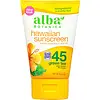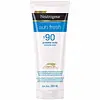What's inside
What's inside
 Key Ingredients
Key Ingredients

 Benefits
Benefits

 Concerns
Concerns

 Ingredients Side-by-side
Ingredients Side-by-side

Butyl Methoxydibenzoylmethane 3%
UV AbsorberHomosalate 10%
Skin ConditioningOctocrylene 10%
UV AbsorberEthylhexyl Salicylate 5%
UV AbsorberWater
Skin ConditioningCetyl Alcohol
EmollientGlycerin
HumectantGlyceryl Stearate Se
EmulsifyingDimethicone
EmollientCaprylic/Capric Triglyceride
MaskingVp/Hexadecene Copolymer
Citrus Aurantium Dulcis Peel Oil
MaskingAloe Barbadensis Leaf Juice
Skin ConditioningCalendula Officinalis Flower Extract
MaskingCamellia Sinensis Leaf Extract
AntimicrobialChamomilla Recutita Flower Extract
MaskingGinkgo Biloba Leaf Extract
Skin ConditioningLavandula Angustifolia Flower Extract
CleansingTocopheryl Acetate
AntioxidantAlcohol
AntimicrobialCetearyl Alcohol
EmollientCetearyl Olivate
Citric Acid
BufferingLinalyl Acetate
MaskingPolysorbate 60
EmulsifyingSodium Chloride
MaskingSodium Stearoyl Glutamate
CleansingSorbitan Olivate
EmulsifyingTriethyl Citrate
MaskingXanthan Gum
EmulsifyingBenzyl Alcohol
PerfumingPotassium Sorbate
PreservativeSodium Benzoate
MaskingAmyl Cinnamal
PerfumingCitral
PerfumingCitronellol
PerfumingGeraniol
PerfumingHydroxycitronellal
PerfumingLimonene
PerfumingLinalool
PerfumingButyl Methoxydibenzoylmethane 3%, Homosalate 10%, Octocrylene 10%, Ethylhexyl Salicylate 5%, Water, Cetyl Alcohol, Glycerin, Glyceryl Stearate Se, Dimethicone, Caprylic/Capric Triglyceride, Vp/Hexadecene Copolymer, Citrus Aurantium Dulcis Peel Oil, Aloe Barbadensis Leaf Juice, Calendula Officinalis Flower Extract, Camellia Sinensis Leaf Extract, Chamomilla Recutita Flower Extract, Ginkgo Biloba Leaf Extract, Lavandula Angustifolia Flower Extract, Tocopheryl Acetate, Alcohol, Cetearyl Alcohol, Cetearyl Olivate, Citric Acid, Linalyl Acetate, Polysorbate 60, Sodium Chloride, Sodium Stearoyl Glutamate, Sorbitan Olivate, Triethyl Citrate, Xanthan Gum, Benzyl Alcohol, Potassium Sorbate, Sodium Benzoate, Amyl Cinnamal, Citral, Citronellol, Geraniol, Hydroxycitronellal, Limonene, Linalool
Water
Skin ConditioningHomosalate
Skin ConditioningOctocrylene
UV AbsorberButyl Methoxydibenzoylmethane
UV AbsorberEthylhexyl Salicylate
UV AbsorberMethylene Bis-Benzotriazolyl Tetramethylbutylphenol
UV FilterStyrene/Vp Copolymer
Glycerin
HumectantCaprylyl Methicone
Skin ConditioningEthylhexyl Triazone
UV AbsorberAluminum Starch Octenylsuccinate
AbsorbentBis-Ethylhexyloxyphenol Methoxyphenyl Triazine
Skin ConditioningSilica
AbrasivePotassium Cetyl Phosphate
EmulsifyingPhenoxyethanol
PreservativeTriacontanyl Pvp
HumectantCetyl Alcohol
EmollientGlyceryl Stearate
EmollientHydroxyacetophenone
AntioxidantTocopheryl Acetate
AntioxidantHydrolyzed Jojoba Esters
Skin ConditioningDimethicone
EmollientPEG-75 Stearate
Parfum
MaskingAcrylates/C10-30 Alkyl Acrylate Crosspolymer
Emulsion StabilisingAcrylates/Dimethicone Copolymer
Skin ConditioningCeteth-20
CleansingSteareth-20
CleansingDisodium EDTA
Jojoba Esters
EmollientAmyl Cinnamal
PerfumingBenzyl Salicylate
PerfumingLimonene
PerfumingWater, Homosalate, Octocrylene, Butyl Methoxydibenzoylmethane, Ethylhexyl Salicylate, Methylene Bis-Benzotriazolyl Tetramethylbutylphenol, Styrene/Vp Copolymer, Glycerin, Caprylyl Methicone, Ethylhexyl Triazone, Aluminum Starch Octenylsuccinate, Bis-Ethylhexyloxyphenol Methoxyphenyl Triazine, Silica, Potassium Cetyl Phosphate, Phenoxyethanol, Triacontanyl Pvp, Cetyl Alcohol, Glyceryl Stearate, Hydroxyacetophenone, Tocopheryl Acetate, Hydrolyzed Jojoba Esters, Dimethicone, PEG-75 Stearate, Parfum, Acrylates/C10-30 Alkyl Acrylate Crosspolymer, Acrylates/Dimethicone Copolymer, Ceteth-20, Steareth-20, Disodium EDTA, Jojoba Esters, Amyl Cinnamal, Benzyl Salicylate, Limonene
 Reviews
Reviews

Ingredients Explained
These ingredients are found in both products.
Ingredients higher up in an ingredient list are typically present in a larger amount.
Amyl Cinnamal is a synthetically produced fragrance. Its scent is reminiscent of jasmine flowers.
Amyl Cinnamal is a known EU allergen. This means it is known to cause skin sensitivity and allergies.
Also known as Avobenzone, this ingredient is a chemical sunscreen filter that provides protection in the UV-A range.
Avobenzone is globally approved and is the most commonly used UV-A filter in the world.
Studies have found that avobenzone becomes ineffective when exposed to UV light (it is not photostable; meaning that it breaks down in sunlight). Because of this, formulations that include avobenzone will usually contain stabilizers such as octocrylene.
However, some modern formulations (looking at you, EU!) are able to stabilize avobenzone by coating the molecules.
Avobenzone does not protect against the UV-B range, so it's important to check that the sunscreen you're using contains other UV filters that do!
The highest concentration of avobenzone permitted is 3% in the US, and 5% in the EU.
Learn more about Butyl MethoxydibenzoylmethaneCetyl Alcohol is a fatty alcohol. Fatty Alcohols are most often used as an emollient or to thicken a product.
Its main roles are:
Though it has "alcohol" in the name, it is not related to denatured alcohol or ethyl alcohol.
The FDA allows products labeled "alcohol-free" to have fatty alcohols.
Learn more about Cetyl AlcoholDimethicone is a type of synthetic silicone created from natural materials such as quartz.
What it does:
Dimethicone comes in different viscosities:
Depending on the viscosity, dimethicone has different properties.
Ingredients lists don't always show which type is used, so we recommend reaching out to the brand if you have questions about the viscosity.
This ingredient is unlikely to cause irritation because it does not get absorbed into skin. However, people with silicone allergies should be careful about using this ingredient.
Note: Dimethicone may contribute to pilling. This is because it is not oil or water soluble, so pilling may occur when layered with products. When mixed with heavy oils in a formula, the outcome is also quite greasy.
Learn more about DimethiconeEthylhexyl Salicylate is an organic compound used to block UV rays. It primarily absorbs UVB rays but offers a small amount of UVA protection as well.
Commonly found in sunscreens, Ethylhexyl Salicylate is created from salicylic acid and 2-ethylhexanol. You might know salicylic acid as the effective acne fighter ingredient and BHA.
The ethylhexanol in this ingredient is a fatty alcohol and helps hydrate your skin, similar to oils. It is an emollient, which means it traps moisture into the skin.
According to manufacturers, Ethylhexyl Salicylate absorbs UV wavelength of 295-315 nm, with a peak absorption at 307-310 nm. UVA rays are linked to long term skin damage, such as hyperpigmentation. UVB rays emit more energy and are capable of damaging our DNA. UVB rays cause sunburn.
Learn more about Ethylhexyl SalicylateGlycerin is already naturally found in your skin. It helps moisturize and protect your skin.
A study from 2016 found glycerin to be more effective as a humectant than AHAs and hyaluronic acid.
As a humectant, it helps the skin stay hydrated by pulling moisture to your skin. The low molecular weight of glycerin allows it to pull moisture into the deeper layers of your skin.
Hydrated skin improves your skin barrier; Your skin barrier helps protect against irritants and bacteria.
Glycerin has also been found to have antimicrobial and antiviral properties. Due to these properties, glycerin is often used in wound and burn treatments.
In cosmetics, glycerin is usually derived from plants such as soybean or palm. However, it can also be sourced from animals, such as tallow or animal fat.
This ingredient is organic, colorless, odorless, and non-toxic.
Glycerin is the name for this ingredient in American English. British English uses Glycerol/Glycerine.
Learn more about GlycerinHomosalate is a chemical sunscreen filter that provides protection in the UV-B range (280nm - 320 nm), with a peak protection at 306 nm. It is internationally approved for use in sunscreens.
Homosalate is not photo-stable, meaning it's strength as a UV filter degrades over time with exposure to the sun. Because of this, it's often used in combination with other chemical sunscreen filters as avobenzone (which protects from the UV-A range). Homosalate also helps act as a solvent for harder-to-dissolve UV filters.
(Part of the reason that sunscreens need to be frequently re-applied is due to the photo instability of many chemical sunscreen filters)
Currently, homosalate is approved in concentrations up to 10% in the EU and 15% in the US. The FDA is currently doing further research on the effects of homosalate, and it is possible that these approved concentrations will change in the future.
Learn more about HomosalateLimonene is a fragrance that adds scent and taste to a formulation.
It's found in the peel oil of citrus fruits and other plants such as lavender and eucalyptus. The scent of limonene is generally described as "sweet citrus".
Limonene acts as an antioxidant, meaning it helps neutralize free radicals.
When exposed to air, oxidized limonene may sensitize the skin. Because of this, limonene is often avoided by people with sensitive skin.
The term 'fragrance' is not regulated in many countries. In many cases, it is up to the brand to define this term. For instance, many brands choose to label themselves as "fragrance-free" because they are not using synthetic fragrances. However, their products may still contain ingredients such as essential oils that are considered a fragrance.
Learn more about LimoneneOctocrylene protects skin from sun damage. It absorbs UV-B with peak absorption of 304 nm. It is a common sunscreen ingredient and often paired with avobenzone, a UVA filter. This is because octocrylene stabilizes other sunscreen ingredients by protecting them from degradation when exposed to sunlight. Octocrylene is a photostable ingredient and loses about 10% of SPF in 95 minutes.
Octocrylene also acts as an emollient, meaning it helps skin retain moisture and softens skin. It is oil-soluble and hydrophobic, enhancing water-resistant properties in a product.
Those who are using ketoprofen, a topical anti-inflammatory drug, may experience an allergic reaction when using octocrylene. It is best to speak with a healthcare professional about using sunscreens with octocrylene.
The EU allows a maximum of these concentrations:
Learn more about OctocryleneTocopheryl Acetate is AKA Vitamin E. It is an antioxidant and protects your skin from free radicals. Free radicals damage the skin by breaking down collagen.
One study found using Tocopheryl Acetate with Vitamin C decreased the number of sunburned cells.
Tocopheryl Acetate is commonly found in both skincare and dietary supplements.
Learn more about Tocopheryl AcetateWater. It's the most common cosmetic ingredient of all. You'll usually see it at the top of ingredient lists, meaning that it makes up the largest part of the product.
So why is it so popular? Water most often acts as a solvent - this means that it helps dissolve other ingredients into the formulation.
You'll also recognize water as that liquid we all need to stay alive. If you see this, drink a glass of water. Stay hydrated!
Learn more about Water